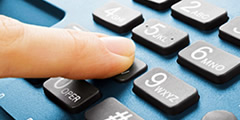
This sound has format mp3.
You can download this sound in best quality from this page and use it for video or music.
A telephone is a telecommunications device that permits two or more users to conduct a conversation when they are too far apart to be easily heard directly. A telephone converts sound, typically and most efficiently the human voice, into electronic signals that are transmitted via cables and other communication channels to another telephone which reproduces the sound to the receiving user. The term is derived from Greek: τῆλε (tēle, far) and φωνή (phōnē, voice), together meaning distant voice. A common short form of the term is phone, which came into use early in the telephone's history.
In 1876, Alexander Graham Bell was the first to be granted a United States patent for a device that produced clearly intelligible replication of the human voice at a second device. This instrument was further developed by many others, and became rapidly indispensable in business, government, and in households.
The essential elements of a telephone are a microphone (transmitter) to speak into and an earphone (receiver) which reproduces the voice at a distant location. The receiver and transmitter are usually built into a handset which is held up to the ear and mouth during conversation. The transmitter converts the sound waves to electrical signals which are sent through the telecommunication system to the receiving telephone, which converts the signals into audible sound in the receiver or sometimes a loudspeaker. Telephones permit transmission in both directions simultaneously.
Most telephones also contain an alerting feature, such as a ringer or a visual indicator, to announce an incoming telephone call. Telephone calls are initiated most commonly with a keypad or dial, affixed to the telephone, to enter a telephone number, which is the address of the call recipient's telephone in the telecommunication system, but other methods existed in the early history of the telephone.
The first telephones were directly connected to each other from one customer's office or residence to another customer's location. Being impractical beyond just a few customers, these systems were quickly replaced by manually operated centrally located switchboards. These exchanges were soon connected together, eventually forming an automated, worldwide public switched telephone network. For greater mobility, various radio systems were developed for transmission between mobile stations on ships and automobiles in the mid-20th century. Hand-held mobile phones were introduced for personal service starting in 1973. In later decades, their analog cellular system evolved into digital networks with greater capability and lower cost.
Convergence in communication services has provided a broad spectrum of capabilities in cell phones, including mobile computing, giving rise to the smartphone, the dominant type of telephone in the world today.
The invention of the transistor in 1947 dramatically changed the technology used in telephone systems and in the long-distance transmission networks, over the next several decades. With the development of stored program control and MOS integrated circuits for electronic switching systems, and new transmission technologies such as pulse-code modulation (PCM), telephony gradually evolved towards digital telephony, which improved the capacity, quality, and cost of the network.
Integrated Services Digital Network (ISDN) was launched in the 1980's, providing businesses and consumers with access to digital telephony services such as data, voice, video, and fax services.
The development of digital data communications methods made it possible to digitize voice and transmit it as real-time data across computer networks and the Internet, giving rise to the field of Internet Protocol (IP) telephony, also known as voice over Internet Protocol (VoIP). VoIP has proven to be a disruptive technology that is rapidly replacing traditional telephone network infrastructure.
By January 2005, up to 10% of telephone subscribers in Japan and South Korea had switched to this digital telephone service. A January 2005 Newsweek article suggested that Internet telephony may be "the next big thing." The technology has spawned a new industry comprising many VoIP companies that offer services to consumers and businesses. The reported global VoIP market in October 2021 was $85.2 billion with a projection of $102.5 billion by 2026.
IP telephony uses high-bandwidth Internet connections and specialized customer premises equipment to transmit telephone calls via the Internet, or any modern private data network. The customer equipment may be an analog telephone adapter (ATA) which translates the signals of a conventional analog telephone; an IP Phone, a dedicated standalone device; or a computer softphone application, utilizing the microphone and headset devices of a personal computer or smartphone.
While traditional analog telephones are typically powered from the central office through the telephone line, digital telephones require a local power supply. Internet-based digital service also requires special provisions to provide the service location to the emergency services when an emergency telephone number is called.
In this page you can download free mp3 sound effects: Telephone mp3 sound effects free download